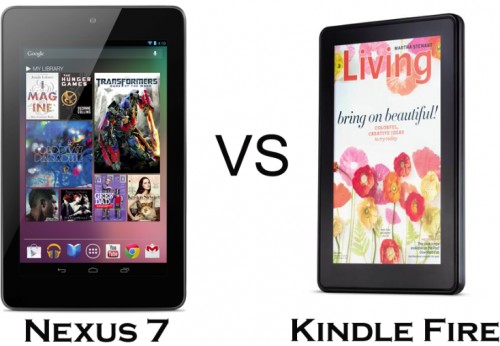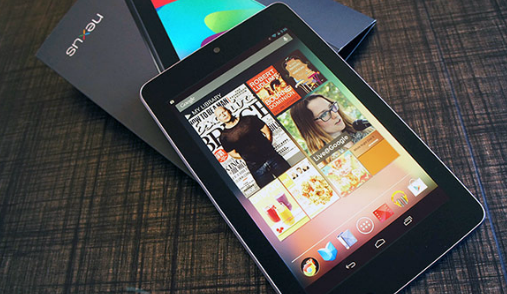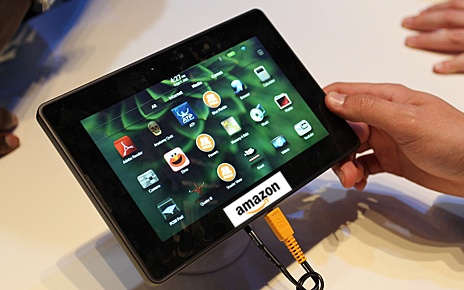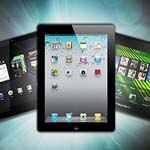The $200 tablet market just got more crowded with the launch of the Google Nexus 7. The Amazon Kindle Fire had turned quite a few heads when it had made its debut appearance in 2011. The price of the Amazon Kindle Fire at a modest $199 seemed too good to be true; more so, because according to earlier reports, the cost had been estimated at $249. However, Google stole Amazon’s thunder by coming out with Google Nexus 7. This new entrant in the world of tablets is competing with the likes of the 8GB Nook and the Amazon Kindle Fire.
The Amazon Kindle Fire with its modest price of $199 is about 7 inches and therefore smaller in dimension compared to its rivals. What counted in its favor was the magnanimous retail support and digital media ecosystem which Amazon boasts of. With Google taking advantage of the apparent shortcomings in Amazon’s brainchild, the consumer world seems to be in the throes of yet another technology war, this time, a battle of the $200 tablets. A brief comparison between these two tablets may help you to take a decision about which may be the best buy for you. You can compare effectively by considering the following features in each:

Highlights of Contents
Hardware
1. Both gadgets resemble each other greatly where dimensions are concerned. While the Kindle Fire is 0.45 inches thick, the Nexus 7 is about 0.41 inches thick. However, the Nexus 7 is relatively lighter, weighing a modest 0.75 lbs.
2. The Nexus 7 is equipped with external volume controls that are not there in the Kindle Fire.
3. The Nexus 7 employs a quad-core chip, the Nvidia Tegra3 that has been clocked to 1.2 GHZ per score, while the Kindle Fire employs an OMAP4 chip set to deliver 1GHZ per score.
4. The Amazon interface is more impressive and the App Store is popular amongst consumers. Embracing Amazon’s strong eco system brings with it certain advantages. When you become Amazon Prime member, you can access the Amazon Kindle Fire lending library that contains titles like “The Hunger Games”. The Nexus 7 gives you access to the Google App Store.
5. In terms of specs, the Nexus 7 scores very high and the user-experience is expected to improve with Tegra 3. The Nexus 7 battery is slightly smaller, but this product can claim a better battery life because Nvidia makes use of a low voltage ARM core for handling background operations. Most Android high-end game creators are in favor of using Tegra 3.
6. Both tablets are fitted with LCD screens. The tablets are also equipped with IPS or in-plane switching facilities that make viewing angles better than before. On a comparative note, resolutions in both are different, where the Nexus 7 has 1280 x 800 resolutions, Amazon Kindle Fire has 1024 x 600. This means that Nexus 7 has better pixel density (216ppi) compared to Kindle Fire’s 170ppi and hence produces sharper images.
7. The Nexus 7 has features like the GPS and near-field communication (NFC) technology. The Kindle Fire on its part has a generic design devoid of features like the Bluetooth, GPS, volume control buttons or front-facing cameras.

Software
1. The Nexus 7 and Amazon Kindle Fire are quite distinct when it comes to their software, although both run on Android. The Kindle Fire does not have any Google App because Amazon built its own customized platform. All searches are executed through Google, but Google does not enjoy a presence on the Kindle Fire. The Nexus 7, on the other hand, boasts of some great apps like Chrome, Maps, Google+ and Gmail. These are not there in Kindle Fire since it is not Google-certified.
2. In the Amazon Kindle Fire, your movies and TV shows, books and magazines appear in a carousel that occupies most of the screen space. Although this carousel is highly responsive, some apps are slow and the drop down for the settings is quite unimpressive. It is only here that you can adjust your screen brightness and volume. While the Fire is unarguably a media consumption gadget, the Nexus 7 has come up with many needed modifications like faster UI, predictive text input features and rich notifications that have been added to Jelly Bean on which it runs. The Nexus is also expected to be prompter. The interface is different from the typical phone interface or the earlier Android tablet interface. It is perhaps less straight-forward than the Kindle Fire, but can guarantee a more real tablet experience.
Ecosystem
1. With every year, the tablet hardware is making substantial progress; so it comes as no surprise that the Nexus 7 hardware is an improvement over the Fire.
2. Since Amazon had always enjoyed solid deals with copyright holders of movies music and books, you can access a great variety of entertainment on the Fire. Nexus 7 cannot boast of such a huge collection although it contains a reasonable amount of books, movies and music.
3. In terms of apps, Google scores higher than the Kindle Fire. There are endless apps present in Google Play and these run well on Android tablets. However, since the Kindle Fire fails to use advanced Android versions supporting tablet features, all these apps have to be separately coded for a single type of device.
4. The Google Play Store comes with a more improved interface compared to the Amazon App Store. There have been serious efforts on part of Mountain View to integrate the web interface with the operating system. This allows the user to push intents for installing and uninstalling apps on the Nexus 7. You will not find this handy feature in the Fire.

To sum up the debate, there are several points on which the Nexus 7 scores higher than the Kindle Fire. Where both software and hardware are concerned, Nexus 7 appears to enjoy a distinct advantage. However, in terms of digital content, the Nexus 7 is yet to offer a strong competition to its rival, the Kindle Fire. Incidentally, there are speculations about the possible launch of a newer and improved Fire. If that happens, the advantages that the Nexus 7 so long enjoyed over the Fire may disappear overnight.
The Nexus 7 from Google remains heavy on the specs that are distinctly impressive for the price, which is at an incredible $200. Consumers are now going to have quite a sleepless night over which tablet to buy. Google’s creation is lighter and sleeker with a longer battery life, better speed and a 1GB RAM equaling the Nook Tablet and higher than the Fire. So, until the time that Amazon comes up with a fitting reply to the Nexus 7 in the form of refreshed Fire, it looks like the Nexus 7 is likely to become the preferred choice amongst consumers. This device stands for the perfect combination of attractive pricing and spectacular features that are undoubtedly an apparent improvement over the shortcomings in the Fire. But to declare it as the clear winner is not a wise thought because comparing a just-launched product with one which has been there in the market for many months now, is unreasonable. It is perhaps better to wait for Amazon’s reply to the Nexus 7 before investing in either.

Being an entertainment lover, i love my Amazon Kindle Fire. Though Nexus has high resolution, providing a better view, I don’t mind waiting for an upgrade to Kindle Fire. A good collection gives bounds me to this tab.